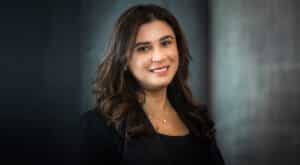Shruti Miyashiro
CEO, Digital Federal Credit Union
Industry experience: 25
Digital Federal Credit Union, better known as DCU, announced recently that it will merge with California-based First Tech Federal Credit Union.
DCU is the largest credit union in Massachusetts and First Tech, headquartered in San Jose, is the largest credit union in the San Francisco Bay Area. Following completion of the merger, the new entity will emerge as a $28.7 billion credit union serving nearly 2 million members with more than 50 branches and a presence in all 50 states under DCU’s charter.
DCU President and CEO Shruti Miyashiro will become president and CEO of the newly combined credit union, which will retain First Tech’s branding.
Q: Can you walk me through the first moments when you thought that a deal could happen with First Tech, and walk me through the process of getting across the finish line?
A: Greg Mitchell, who’s the CEO at First Tech, and I have talked about this being a one-of-one, so we were not searching for mergers for the sake of mergers and growth for the sake of growth. Everything that we have done at each of our institutions has been very intentional with an eye on the “people experience.” As we learned more about each of our credit unions and our focus, we have jokingly but fondly referred to each other as kind of the East Coast and West Coast twins. We are very similar in the story of how we were each founded by technology companies that, while they no longer exist as companies, they were formed as their spirit of innovation, the way they were delivering technology, the way they built up the workplace – we both still continue those legacies. First Tech was founded by Tektronix. DCU, of course, was founded by Digital Equipment Corporation, which, even over 20 years since its merger with Compaq, is so fondly remembered by all of our residents here [in MetroWest]. We have similar origin stories, right down to the fact that both of us have foundations that are focused on children’s wellbeing. We also have very similar focuses: We truly focus on people, from employees and members, which a lot of companies will talk about, but the proof is always in the experience. It’s in your Glassdoor ratings, it’s in what members are saying about you. We really focus on that as our barometer of success.
Everything about us is so similar, from origin to values to the people that we’re serving, and even our foundations, so it was very easy when we started talking. Greg was looking at retiring, and so we started to talk a little bit about retirement, his retirement plans, where he was going. We also recognized some of the challenges that financial institutions are facing with rapid consolidation, and so we were able to say that’s not a problem for us. But doesn’t this leapfrog what we can do better and faster for all of our consumers? So, the genesis was just a mutual respect, a shared vision and shared values, and it morphed into good timing and an opportunity to bring two really healthy financial institutions together for further growth.
Q: How do you approach making that leap into a new territory?
A: So interestingly, at DCU, 50 percent of our members are in-footprint, which is predominantly Massachusetts and New Hampshire. The other 50 percent are completely out-of-market, meaning there’s not a branch nearby. We have a lot of members who are out-of-market in places like New Jersey and New York, but we also have a lot of members who are out-of-market in Texas, California, Washington, Oregon and even Colorado. They’re spread throughout the nation, and we have, as a digital credit union, been serving their needs extensively. What we will have [post-merger] will be two strong branch footprints on the West Coast, with the California, Oregon, Washington branches, very specifically coming from First Tech and then the East Coast, where we have our DCU branches.
We are planning on maintaining our branch presence on both coasts and then continuing to serve members throughout the nation digitally. We’re finding fewer and fewer members are really going into branches, but when life happens, they want to be able to connect with a person, which is by branch or even video meetings, phone calls or chats. So, the delivery has expanded but our own members’ migratory patterns, which were rooted in Massachusetts and New Hampshire due to our DEC founding, shifted even without us trying. We also have a lot of referrals of family members. DCU has grown organically through our core members and then referrals of family members, so they’re all over the nation, so this won’t be new to us.
Q: There’s a general expectation of more bank M&A looking ahead to 2025 and beyond. Just what does the M&A projection look like for DCU?
A: We’re focused on doing things well and not focused on quantity, so this is not about chasing growth or chasing scale or chasing mergers. Our goal is to make sure everything we do is done very intentionally. I always say: do a few things and do them really well. Our goal for 2025 and 2026 is to work on having a really strong pre-planning and integration experience. That’s it. That’s our definition of success, because then we can continue our past record of organic growth. There’s nothing more frustrating than mergers that don’t go well and system problems for consumers, so we are very focused on taking care of our employees through the merger and then also taking care of our members through the merger with systems – not chasing M&A just for the sake of checking another one off the list.
Miyashiro’s Five Favorite Books
- “Man’s Search for Meaning” by Victor Frankl
- “Interpreter of Maladies” by Jhumpa Lahiri
- “Learning, Fast & Slow” by Dr. Nathan Belcher
- “A Little Princess” by Frances Hodgson Burnett
- “Of Mice and Men” by John Steinbeck







